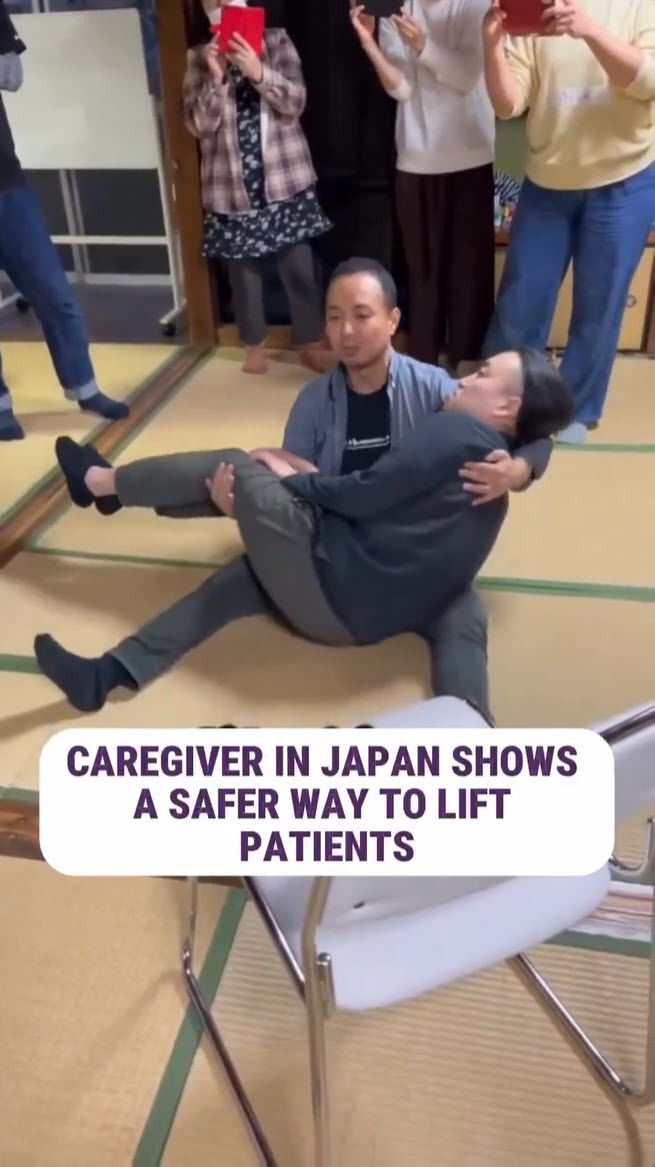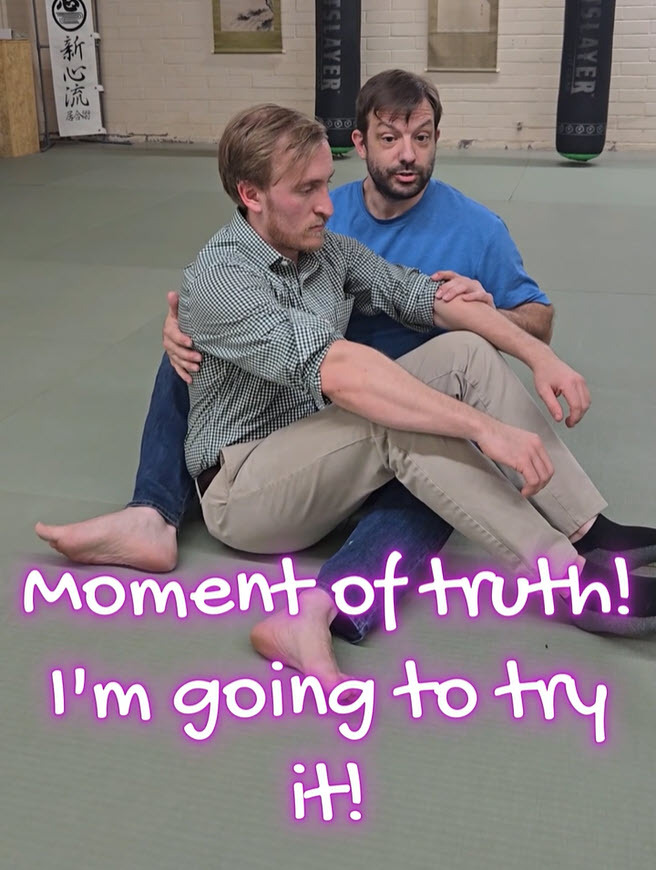- The Dementia Newsletter, by elumenEd
- Posts
- Don't Try This at Home: Transfers from Japan!
Don't Try This at Home: Transfers from Japan!
Also in this edition: Silence and Healing for Dementia Anxiety; Ways to Support the Alzheimer's Association's Walk to End Alzheimer's

In this edition: |
|---|
• 🎥 Videos: Transfer Ergonomics Master Class! 🎞️ |
Videos: Don’t Try This at Home! Japanese Body Mechanics and Transfers
Being a caregiver is capital-D dangerous! This is primarily because of transferring others: helping someone from seated to standing, moving to a toilet or a bed, helping someone walk, getting into a shower, and so on.
It’s tough to quantify just how many home and family caregivers are injured in the process of transfers because most of those injuries aren’t documented. However, we do know that, among professional caregivers and nurses, the healthcare profession is more dangerous than working in a coal mine, a steel mill, or a prison!
Far and away, transfers are the most dangerous thing we do when caring for another.
This is an area of special interest to me because I saw these injuries for decades in the senior living industry, and virtually nothing has been done about it. There haven’t been any particular updates to ergonomics. We just keep doing the same thing and expecting something different.
Because I’ve spent 40 years in martial arts, I have a unique perspective on body mechanics. We have giant holes in our transfer training that I’m working to fill in with my own experience through my Eastern Ergonomics program at elumenEd.
There are better ways to do transfers that we haven’t particularly explored yet in the West.
I stumbled across a fascinating clip from Japan last week. It shows a Japanese caregiver using a martial arts mechanic to transfer someone from the floor to a seated position. It kind of blew up on my LinkedIn so there’s some real interest. I wanted to share it with you!
To be very clear, I don’t recommend that you try this particular transfer! It’s a complicated movement and you really need to have some training to pull it off safely. But it’s definitely interesting, and it shows you what is possible when you have great mechanics. Check it out!
Even though it was presented in Japanese (and I don’t speak Japanese), I do “speak” the mechanics that he’s using. It was such an interesting idea that I had to head to the dojo and try it out for myself. I grabbed one of my students—the lightest person in the room!—and gave it a shot.
Other than showing my best effort to reproduce the movement, I explain in English what’s actually happening with the muscles and skeletal structure of the body. This is what martial artists might call “internal” martial arts. It’s what’s actually happening inside the body to make things work.
Here’s the video I made reviewing this technique. I hope you enjoy it! (Again, please don’t try this at home!)
Poll: Upping Your Transfer Game
After reading the article and watching the two videos, what would be most valuable to you next? |
|
Help Keep the Caregiver Stories Coming
If this newsletter has helped you, would you consider supporting it?
Every week, I pour my heart into these words to make your caregiving journey a little lighter and less lonely. Many of you have shared how these stories have brought comfort, perspective, or even a smile on a hard day.
If you’ve ever found a moment of relief or recognition here, I hope you’ll consider tipping—$5, $10, or whatever feels right to you. Your support helps me keep writing, and reminds me how much this work matters.
Thank you for being part of this community.
Caregiver’s Corner: Silence and Healing for Dementia Anxiety
At my mom’s memory care community, there’s a particular resident who has a great deal of anxiety. The staff does a tremendous and compassionate job of calming her, but I still see her regularly wandering, looking like she is about to burst into tears. She will take the bottom of her shirt and rub the hem between her fingers and thumbs over and over. She paces back and forth, and you can tell she’s nervous by her tone of voice.
I gravitate toward her. I understand anxiety and loneliness. I see the look in her eyes and I know it because I have seen it in the mirror, looking back at me, so often.
She seems to like me too. She always comes over, sits beside me, and talks to me. I think it’s because I treat her like I want people to treat me when I’m suffering. I don’t try to fix anything. I don’t tell her it’s ok. I don’t tell her not to worry about things.
Instead, I become as intensely present as I’m able to be. I listen as closely as I can. Even though I don’t understand what she’s talking about, I respond to the emotion on her face and validate it with looks of understanding and compassion. I help her understand that her feelings are valid and important, and I don’t try to make them go away or tell her she shouldn’t be concerned. Her feelings are allowed and accepted.
Just like this resident, I’m concerned about plenty of things in life. Maybe you are too. For instance, I’m concerned about my mom’s journey through Alzheimer’s disease. How do you think I’d respond to someone who says “don’t worry about it”? How would you respond? I’d much rather someone gave me their attention and listened deeply.
This very human need for understanding doesn’t change because someone has dementia. Just because we don’t understand why someone feels anxious, we can understand that they feel anxious.
As she talks and I listen intensely, she starts to calm a bit. Slowly she stops fiddling with her shirt. Her face relaxes bit by bit, and her speech slows. Often, she looks at me with gratitude, says “thank you,” and sits down quietly with me or walks away more at peace.
I think it’s hard for us when we can’t solve a problem someone else has. When they describe their feelings, out of the kindness in our hearts, we want to fix things and help them. This is problem-focused, rather than person-focused, and it actually takes the person out of the process. When we can’t understand the problem because dementia interrupts communication, solving the problem often isn’t an option.
Thoughtful, validating listening becomes our best tool. I compare it to having a conversation with someone speaking a language I barely understand. I listen so much more carefully for the slightest pieces that will give me a clue to what is being said, and I’d rather not speak and reveal how little I understand.
I learned the tremendous and transformative power of profound listening on a single day in 2009. My (ex-)wife had just announced that she was leaving me. Her departure threw me into a tailspin of depression, anger, insecurity, and shame.
I’ve practiced Zen meditation since 2005, so I went to my teacher. He was unique in that he was also a Catholic priest. He was one of the quietest people I’ve known, so when he spoke his words carried great weight.
I went to his office at the Catholic retreat center and spewed. He responded with the most intense listening I have ever experienced, cultivated over his decades of silent practice. His quiet presence was so intense I almost felt like I could touch it.
I thought I could talk for hours and hours about how terribly I felt, but after 30 minutes of being truly heard I ran out of hurt. I wasn’t fixed or healed, but something shifted. Someone cared enough to really listen, even though there was no way to fix things. We retired from the stillness of his office to the stillness of our meditation cushions.
He passed away in 2012, and I still miss him dearly. 16 years after that encounter, it continues to inform my relationships, my care for others, and the care I give myself. His listening transformed something in me, and I try to give that gift to others in my own way.
Problems are held in the heart. When we can’t understand why someone with dementia is upset, can we understand what it is to be upset? Can we remember that feeling of the queasy stomach, the tight chest, or the fuming thoughts? Can we hold that person’s heart with compassion, understanding the feeling without understanding their reason? Can we sit quietly and attentively in the moment?
For most of us, this isn’t intuitive. It takes practice to be still. Listening without fixing is hard work. However, if you really want to help your loved one, this might be exactly what they need. It might be the only thing you can do.

🚶♀️ The 2025 Walk to End Alzheimer’s 🚶♂️
The Dementia Newsletter’s 2025 Alzheimer’s Walk Team: would you like to do something proactive to fight Alzheimer’s disease? Please consider donating to my walk team for the Alzheimer’s Association’s Walk to End Alzheimer’s. Heck, if you’re in Tucson sign up to come walk with us! Even $1 puts your name on the list and lets the world (including the politicians who make funding decisions) know that beating this disease is important to you.
Find a team or location for your local Walk to End Alzheimer’s: if you’d like to find a local walk to attend, visit this site for the information you’ll need. It’s a great time to bond with other people who are engaged in this fight.

Ben Couch, author
I’ve been a dementia professional for over 20 years, but the fight against this disease has become much more personal for me as I am engaged in my mother’s journey with Alzheimer’s disease. I started The Dementia Newsletter as well as it’s parent company, elumenEd, to help caregivers — specifically home and family caregivers — gain access to the very best training and information available at an affordable price.
SOME OF THE LINKS IN THIS NEWSLETTER ARE AFFILIATE LINKS, WHICH MEANS WE MAY EARN A COMMISSION IF YOU CLICK AND MAKE A PURCHASE, AT NO ADDITIONAL COST TO YOU. WE ONLY RECOMMEND PRODUCTS AND SERVICES WE TRUST.
At The Dementia Newsletter, we’re dementia professionals but we’re not medical doctors or lawyers. The information provided is for general informational purposes only and should not be considered as medical or legal advice. Always consult with a qualified healthcare professional for medical diagnosis, treatment, or any health-related concerns and consult with a lawyer regarding any legal matters.



Reply